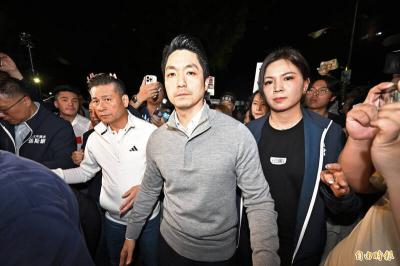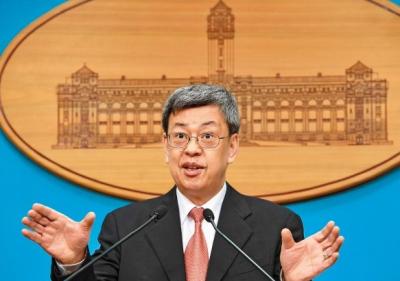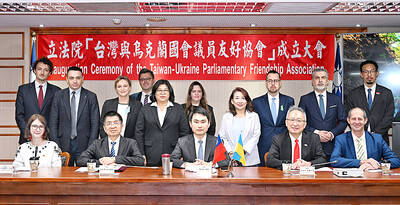A recent report on China’s nuclear weapons capabilities has re-ignited debate on the country’s nuclear policy and the overall lack of transparency surrounding the People’s Liberation Army (PLA).
In its China’s Nuclear Arsenal: Status and Evolution briefing paper released on Monday last week, the Union of Concerned Scientists (UCS) said the Chinese government had no intention of reaching numerical parity with the US on nuclear weapons and did not have the nuclear material to do so.
Released to coincide with the arrival of PLA Chief of General Staff Chen Bingde (陳炳德) in Washington, the paper said recent advances in China’s nuclear forces were intended to ensure the arsenal would survive an attack and preserve China’s ability to retaliate.
Beijing was not focused on increasing its offensive capability, it said, and its relatively small nuclear arsenal is solely for deterrent purposes.
“Some members of [US] Congress and the intelligence community overstate China’s nuclear capabilities and the scope of changes it is making to them,” said UCS China project manager Gregory Kulacki, who authored the paper. “Claims that China is rapidly modernizing its nuclear arsenal and seeks numerical parity with the United States are contradicted by the facts we can nail down about China’s nuclear arsenal.”
According to the report’s findings, China currently possesses an arsenal consisting of about 155 nuclear warheads ready to be deployed on six types of land-based missiles. It also said that limited stocks of plutonium “significantly constrain China’s ability to increase the size of its nuclear arsenal” and adds that “China’s focus is on improving its delivery systems to increase their survivability, and not on designing or developing new nuclear warheads.”
“China’s lack of nuclear testing since it signed the Comprehensive Nuclear Test Ban Treaty in 1996 restricts its ability to develop and deploy new, smaller warhead designs,” it says.
Seen as the latest salvo in an ongoing debate on China’s nuclear missile arsenal and strategy, the report has been met with some skepticism by defense experts, who say that the UCS may have underestimated the number of nuclear warheads in the PLA arsenal.
“Promoting continued nuclear weapons reductions is a core mission for the UCS, so making sure nobody ‘overestimates’ PLA nuclear capabilities and intentions — which of course the PLA seeks to keep as secret as possible — is a high priority for the Union as well,” Rick Fisher, a senior fellow at the International Assessment and Strategy Center in Washington, told the Taipei Times.
Kulacki’s insistence that the fundamental purpose of China’s nuclear arsenal is to prevent or counter foreign military coercion was simply wrong, Fisher said, adding that despite China’s declared “no first use” policy, there was “ample literature” and “PLA statements” pointing to a substantial coercive mission for China’s nuclear forces — especially as concerns a potential Taiwan contingency. It is believed by many experts that under certain circumstances, for example, China could detonate a nuclear device at high altitude to disrupt Taiwan’s electronic capabilities or destroy those of a carrier battle group at sea.
“This is why it is crucial that the US not get this wrong, and why it is critical that the US government be much more forthright about developing PLA strategic capabilities,” Fisher said. “The PLA is not going to tell us anything.”
Beyond a lack of transparency, which has haunted China’s relations with other countries on every aspect of its military, another problem with bean counting China’s nuclear arsenal derives from the metrics used for that assessment. As another specialist on the Chinese military told the Taipei Times, counting delivery vehicles alone is a limited basis for assessing the actual number of warheads.
The Second Artillery, which is responsible for China’s nuclear forces and also holds a large conventional missile arsenal, reportedly does not keep warheads mated with delivery vehicles in peacetime, and missile components are also believed to be stored separately.
China stores most warheads and/or warhead components at a central depot in the Qinling Mountains in Shaanxi Province. Each of the six missile bases has a warhead storage and handling facility, but there does not seem to be a permanent allocation of stored warheads, the analyst said. All of this makes it nearly impossible to assess the total number of warheads with certainty.
Furthermore, there reportedly has been substantial tunneling work at Qinling in the past decade and throughout the Second Artillery as a whole. It remains unclear, however, whether warhead depot-related tunneling work is for expansion purposes — in other words, to store more warheads — or just refurbishment.
Also not mentioned in the report is Chinese potential for nuclear capable land attack cruise missiles.
Another point of disagreement lies in the report’s contention that the DF-31 and DF-31A solid-fuel, long-range missiles China has -begun deploying in recent years to complement liquid-fuel missiles designed in the 1970s “cannot carry more than one of China’s smallest warheads.”
Asian sources maintain that the DF-31A and JL-2 missiles are expected to eventually have multiple warheads, and there are indicators that a variant of the DF-5 intercontinental ballistic missile (ICBM), which is believed to have been introduced in recent years, could come with multiple warheads. In Fisher’s view, Kulacki is downplaying Chinese interest in, and its ability to develop, multiple independent re-entry vehicle (MIRV) capabilities, which could result in a grossly underestimated total nuclear arsenal.
“The report also gives short treatment to the yet unnamed new large mobile ICBM we have been seeing in Internet source images since 2007,” Fisher said, adding that some of his sources had informed him this missile could carry as many as 10 warheads.
“With these two high potential MIRV missiles alone, the PLA has the potential to field hundreds of new warheads rather quickly if it so desires,” he said.
There has also been chatter on Chinese defense sites of advanced longer-range versions of the JL-2, as well as a possible JL-3 -submarine-launched ballistic missile for the anticipated Type 096 submarine, a potential addition to the Type 094 currently being built.
Another aspect of China’s military that is not fully taken into consideration in the report is the development of missile defense capabilities, a factor that could substantially increase Beijing’s ability to use nuclear blackmail over -Taiwan and in other contingencies.
Fisher said he also had doubts about the report’s contention that China had limited access to plutonium. Estimates of the size of China’s plutonium stock, the report says, are uncertain, but imply that the number of new warheads that could be produced from that stock would be limited, probably from “very few” to a “several hundred.”
However, while China has halted production of military plutonium, it has not declared an official moratorium. And while Beijing officially supports negotiations on a Fissile Material Cut-off Treaty that would ban all future production for weapons use, Chinese concerns about US missile defense systems have diminished its enthusiasm for the treaty, the UCS report said.
There are also reports that China recently began operating a pilot plant for reprocessing spent fuel rods from civilian nuclear reactors and operates an experimental fast breeder reactor. If it chose, China could divert plutonium from those two plants for weaponization, it said.
“How do we know there does not exist a separate underground PLA network for fissile production that we would likely never see? There is also the matter of the PLA deciding to make warheads with smaller amounts of fissile material, meaning any fixed amount can result in a greater number of warheads,” Fisher said.
Yet another factor could be technologies that enable more efficient use of available fissile material, he said, adding that lack of current, detailed information on China Academy of Engineering Physics research institutes and factories that could be actively involved in warhead-related work was another blind spot.

Several Chinese Nationalist Party (KMT) officials including Chairman Eric Chu (朱立倫) are to be summoned for questioning and then transferred to prosecutors for holding an illegal assembly in Taipei last night, the Taipei Police said today. Chu and two others hosted an illegal assembly and are to be requested to explain their actions, the Taipei City Police Department's Zhongzheng (中正) First Precinct said, referring to a protest held after Huang Lu Chin-ju (黃呂錦茹), KMT Taipei's chapter director, and several other KMT staffers were questioned for alleged signature forgery in recall petitions against Democratic Progressive Party (DPP) legislators. Taipei prosecutors had filed

Taiwan would welcome the return of Honduras as a diplomatic ally if its next president decides to make such a move, Minister of Foreign Affairs Lin Chia-lung (林佳龍) said yesterday. “Of course, we would welcome Honduras if they want to restore diplomatic ties with Taiwan after their elections,” Lin said at a meeting of the legislature’s Foreign Affairs and National Defense Committee, when asked to comment on statements made by two of the three Honduran presidential candidates during the presidential campaign in the Central American country. Taiwan is paying close attention to the region as a whole in the wake of a

President William Lai (賴清德) has appointed former vice president Chen Chien-jen (陳建仁) to attend the late Pope Francis’ funeral at the Vatican City on Saturday on his behalf, the Ministry of Foreign Affairs said today. The Holy See announced Francis’ funeral would take place on Saturday at 10am in St Peter’s Square. The ministry expressed condolences over Francis’ passing and said that Chen would represent Taiwan at the funeral and offer condolences in person. Taiwan and the Vatican have a long-standing and close diplomatic relationship, the ministry said. Both sides agreed to have Chen represent Taiwan at the funeral, given his Catholic identity and

Lawmakers from the Democratic Progressive Party (DPP) yesterday established a friendship group with their counterparts in Ukraine to promote parliamentary exchanges between the two countries. A ceremony in Taipei for the Taiwan-Ukraine Parliamentary Friendship Association, initiated by DPP Legislator Chen Kuan-ting (陳冠廷), was attended by lawmakers and officials, including Deputy Minister of Foreign Affairs Francois Wu (吳志中) and European Economic and Trade Office in Taiwan Director Lutz Gullner. The increasingly dire situation in Ukraine is a global concern, and Taiwan cannot turn its back when the latter is in need of help, as the two countries share many common values and interests,